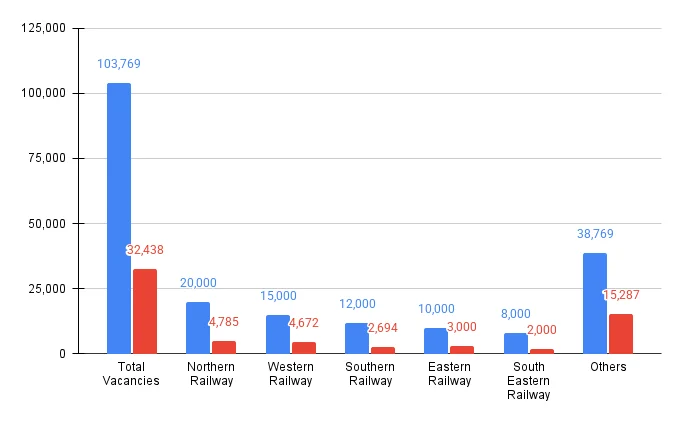Last updated on October 24th, 2025 at 10:04 am
RRB Group D Vacancy Analysis: The Railway Recruitment Board (RRB) Group D examination serves as a significant gateway for candidates aspiring to join the Indian Railways. Over the years, the number of vacancies and their distribution across states have varied, reflecting the dynamic needs of the railway network. Understanding this distribution is crucial for aspirants to strategise their preparation effectively.
RRB Group D Vacancy Trends Over the Years
RRB Group D vacancy distribution highlighted the regions with the most significant infrastructure development and maintenance needs. Check out the RRB Group D Vacancy trends over the years:
1. RRB Group D 2022
In 2022, the RRB announced a total of 1,03,769 vacancies across various zones. The distribution was as follows:
- Northern Railway (NR): 20,000 vacancies
- Western Railway (WR): 15,000 vacancies
- Southern Railway (SR): 12,000 vacancies
- Eastern Railway (ER): 10,000 vacancies
- South Eastern Railway (SER): 8,000 vacancies
- Others: 38,769 vacancies
2. RRB Group D 2025
For the year 2025, there were 32,438 vacancies under notification CEN-08/2024 in the official RRB Group D Notification. The zone-wise distribution was:
- Northern Railway (New Delhi): 4,785 vacancies
- Western Railway (Mumbai): 4,672 vacancies
- Southern Railway (Chennai): 2,694 vacancies
- Eastern Railway (Kolkata): 3,000 vacancies
- South Eastern Railway (Kolkata): 2,000 vacancies
- Others: 15,287 vacancies
This distribution indicates a balanced approach, ensuring that all regions receive adequate staffing to maintain operations efficiently.
Factors Influencing Vacancy Distribution
Several factors contribute to the variation in vacancy distribution across states. Some of them are as follows:
- Infrastructure Development: Areas with ongoing projects require more personnel to manage and maintain new facilities.
- Retirement Rates: Regions with higher retirement rates may have more vacancies to fill.
- Operational Needs: Zones with higher train frequencies and passenger volumes necessitate more staff for smooth operations.
- Budget Allocations: Financial resources allocated to different zones influence the number of vacancies announced.
Comparison of RRB Group D Vacancy Trends
A comparison table has been given below showing the vacancy trends of the Group D posts. Check out the details below:
| Year | Total Vacancies | Northern Railway | Western Railway | Southern Railway | Eastern Railway | South Eastern Railway | Others |
| 2022 | 103,769 | 20,000 | 15,000 | 12,000 | 10,000 | 8,000 | 38,769 |
| 2025 | 32,438 | 4,785 | 4,672 | 2,694 | 3,000 | 2,000 | 15,287 |

Key Insights
The major points of the article are summarized below:
- Decline in Total Vacancies: There was a significant decrease in the total number of vacancies from 2022 to 2025. This could be attributed to various factors, including automation, improved efficiency, and budget constraints.
- Stable Regional Demand: Despite the overall decline, the demand for personnel in specific regions like Northern and Western Railways remained relatively stable, indicating consistent operational needs.
- Emerging Regions: Some regions, such as South Eastern Railway, saw an increase in vacancies, possibly due to new projects or increased operational requirements.
The state-wise vacancy analysis of RRB Group D over the years provides valuable insights into the evolving staffing needs of the Indian Railways. Aspirants should consider these trends when strategising their preparation, focusing on regions with higher vacancy announcements. Staying informed about the latest notifications and understanding regional requirements can enhance their chances of success in the RRB Group D examination.
FAQs
The total vacancies vary by year depending on railway operational needs. For example, 2022 saw around 1,03,769 vacancies, while 2025 had approximately 32,438 vacancies. These numbers can change based on retirements, infrastructure expansion, and budget allocations.
Historically, Northern Railway (NR) and Western Railway (WR) consistently have the highest vacancies due to higher operational requirements and infrastructure projects. Other zones like Southern Railway (SR) and Eastern Railway (ER) also have substantial vacancies but slightly lower in comparison.
Vacancy distribution depends on several factors:
Rate of employee retirements in each zone
New infrastructure and railway projects
Passenger and freight traffic volumes
Budget allocations for recruitment in each region
Understanding state-wise vacancies helps candidates:
Identify zones with higher opportunities
Choose preferred zones strategically
Focus on competitive planning for high-demand regions
Prepare mentally for zone-specific exam trends
Official notifications and updates can be accessed through:
RRB official websites for each zone
Employment news and railway recruitment portals
Government publications like the Press Information Bureau (PIB) for central announcements
- RRB Group D City Intimation Slip 2025, View City Slip and Shift Timings
- RRB Group D Vacancy Trend Analysis, Check Details
- रेलवे परीक्षा की तैयारी करें, सारी जानकारी यहां देखें
- RRB Group D Study Plan for 15 Days, Check Daily Schedule
- Important RRB Group D Exam Day Guidelines, Check Now
- Important Biology Chapters for RRB Group D Exam, Know Details

Hello! This is Arijit Dutta. I am a skilled Content Writer at Oliveboard with nearly 3+ years of experience in crafting engaging, informative, and exam-focused content for the Railways Domain. With a strong command of language and a keen understanding of learner needs, I contribute significantly to Oliveboard’s mission of delivering high-quality educational resources. Passionate about clear communication and continuous learning, I consistently create content that helps government job aspirants achieve their goals. Outside of work, I enjoy playing cricket and listening to music, which helps me stay balanced and creative in my professional journey.
